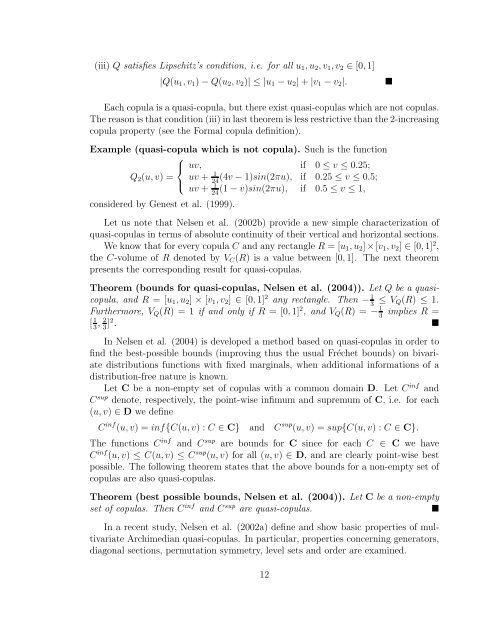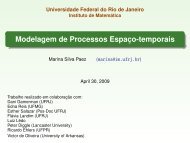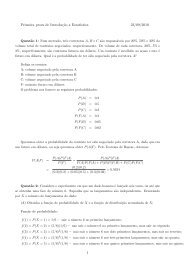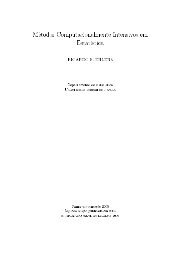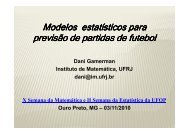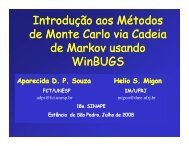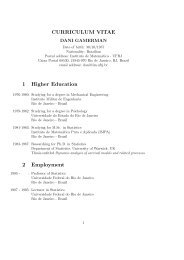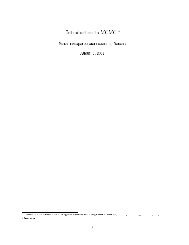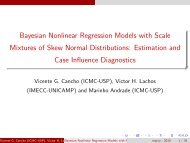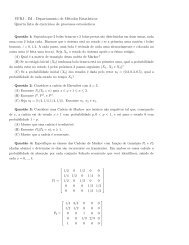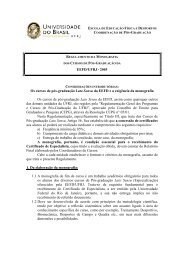Copulas: a Review and Recent Developments (2007)
Copulas: a Review and Recent Developments (2007)
Copulas: a Review and Recent Developments (2007)
You also want an ePaper? Increase the reach of your titles
YUMPU automatically turns print PDFs into web optimized ePapers that Google loves.
(iii) Q satis¯es Lipschitz's condition, i.e. for all u 1 ;u 2 ;v 1 ;v 2 2 [0; 1]jQ(u 1 ;v 1 ) ¡ Q(u 2 ;v 2 )j·ju 1 ¡ u 2 j + jv 1 ¡ v 2 j: ¥Each copula is a quasi-copula, but there exist quasi-copulas which are not copulas.Thereasonisthatcondition(iii)inlasttheorem is less restrictive than the 2-increasingcopula property (see the Formal copula de¯nition).Example (quasi-copula which is not copula). Such is the function8< uv; if 0 · v · 0:25;Q 2 (u; v) = uv + 1 (4v ¡ 1)sin(2¼u); if 0:25 · v · 0:5;:24uv + 1 (1 ¡ v)sin(2¼u); if 0:5 · v · 1;24considered by Genest et al. (1999).LetusnotethatNelsenetal. (2002b)provide a new simple characterization ofquasi-copulas in terms of absolute continuity of their vertical <strong>and</strong> horizontal sections.We know that for every copula C <strong>and</strong> any rectangle R =[u 1 ;u 2 ]£[v 1 ;v 2 ] 2 [0; 1] 2 ,the C-volume of R denoted by V C (R) is a value between [0; 1]. The next theorempresents the corresponding result for quasi-copulas.Theorem (bounds for quasi-copulas, Nelsen et al. (2004)). Let Q be a quasicopula,<strong>and</strong> R =[u 1 ;u 2 ] £ [v 1 ;v 2 ] 2 [0; 1] 2 any rectangle. Then ¡ 1 3 · V Q(R) · 1.Furthermore, V Q (R) =1if <strong>and</strong> only if R =[0; 1] 2 ,<strong>and</strong>V Q (R) =¡ 1 3 implies R =[ 1; 2 3 3 ]2 . ¥In Nelsen et al. (2004) is developed a method based on quasi-copulas in order to¯nd the best-possible bounds (improving thus the usual Frechet bounds) on bivariatedistributions functions with ¯xed marginals, when additional informations of adistribution-free nature is known.Let C be a non-empty set of copulas with a common domain D. Let C inf <strong>and</strong>C sup denote, respectively, the point-wise in¯mum <strong>and</strong> supremum of C, i.e. foreach(u; v) 2 D we de¯neC inf (u; v) =inffC(u; v) :C 2 Cg <strong>and</strong> C sup (u; v) =supfC(u; v) :C 2 Cg:The functions C inf <strong>and</strong> C sup are bounds for C since for each C 2 C we haveC inf (u; v) · C(u; v) · C sup (u; v) forall(u; v) 2 D, <strong>and</strong> are clearly point-wise bestpossible. The following theorem states that the above bounds for a non-empty set ofcopulas are also quasi-copulas.Theorem (best possible bounds, Nelsen et al. (2004)). Let C be a non-emptyset of copulas. Then C inf <strong>and</strong> C sup are quasi-copulas. ¥In a recent study, Nelsen et al. (2002a) de¯ne <strong>and</strong> show basic properties of multivariateArchimedian quasi-copulas. In particular, properties concerning generators,diagonal sections, permutation symmetry, level sets <strong>and</strong> order are examined.12


